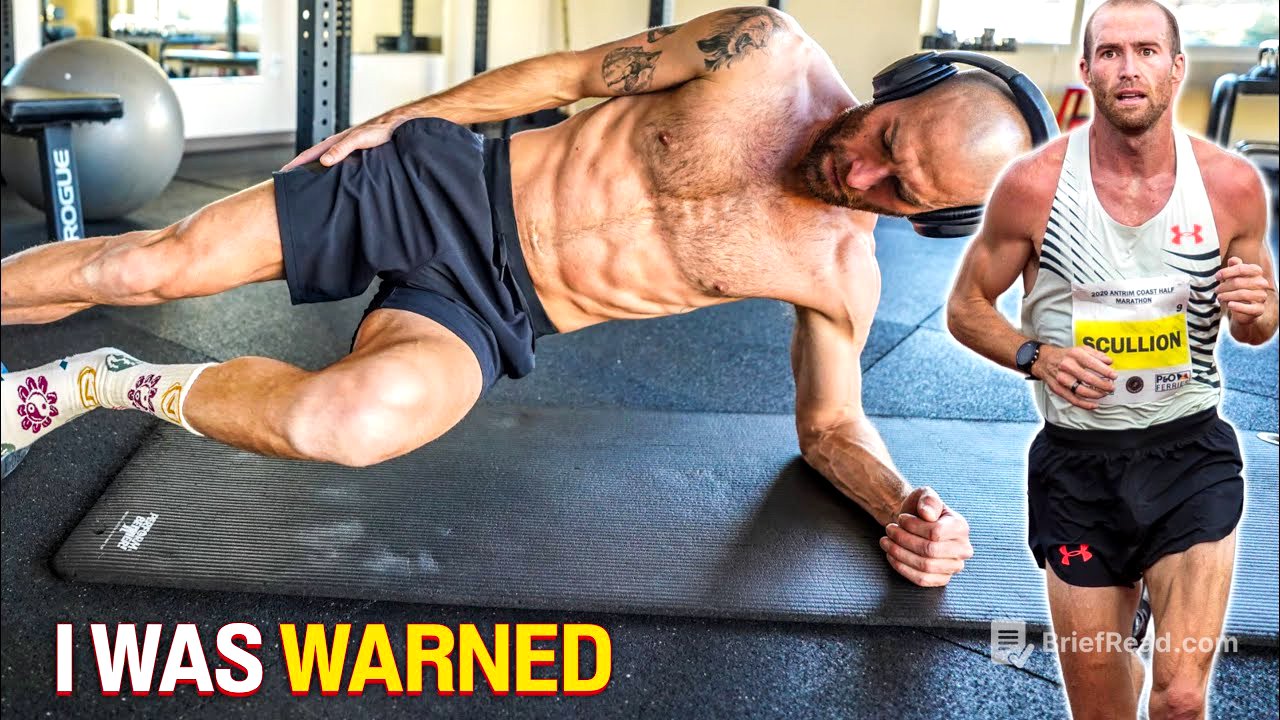TLDR;
Stephen Scullion emphasizes the importance of incorporating gym workouts into a runner's routine to enhance performance and prevent injuries. He shares a gym routine focusing on strengthening key muscle groups like calves, hamstrings, glutes, and quads, using exercises that mimic running movements. The routine includes calf exercises, hamstring holds, glute bridges, lunges, plyometrics, and squats, with an emphasis on proper form and controlled movements rather than lifting heavy weights.
- Prioritize gym workouts to enhance running performance and prevent injuries.
- Focus on strengthening key muscle groups: calves, hamstrings, glutes, and quads.
- Incorporate single-leg exercises and plyometrics to mimic running movements.
- Emphasize proper form and controlled movements over lifting heavy weights.
- Consistency and manageable routines are key to seeing benefits.
Mo Farah's Advice and Gym Importance [0:00]
Stephen Scullion recounts advice from Mo Farah about the importance of gym work for runners. Farah advised him to get back in the gym to strengthen his body after a half marathon. Scullion highlights that gym work helps runners access their full fitness potential, preventing physical breakdowns, injuries during training, and performance decline on race day. He notes that runners often prioritize running over gym workouts, but gym work is crucial for overall fitness and injury prevention.
Gym Routine Introduction [1:39]
Stephen Scullion discusses his gym routine, typically performed on Wednesdays or Sundays, and emphasizes the flexibility of incorporating it before or after runs. He stresses the importance of consistency, aiming for two to three times per week. He admits to feeling weak during a recent gym session, highlighting the need to improve physical strength to support his running goals.
Calf Exercises [2:31]
Stephen Scullion always begins his gym routine with calf exercises, as the calves are the first point of contact with the ground during running. Strengthening the calves helps prevent other muscles like quads, hamstrings, and glutes from overworking. His routine includes calf walks, calf raises (single and double leg), and calf holds, using equipment like a box or leg press machine. He aims for two to three calf exercises, focusing on stimulating the muscles without pushing to failure.
Hamstring and Glute Exercises [4:05]
After calves, Stephen Scullion moves to hamstring exercises, such as hamstring holds, Romanian deadlifts (RDLs), and single-leg RDLs. He focuses on maintaining proper technique, particularly tucking the pelvis. He also incorporates glute exercises like glute bridges, box step-ups, and activation routines before and after runs to address chronically tight glutes. He adjusts the lever length during glute bridges to isolate the glutes more effectively.
Quad and Integrated Muscle Exercises [7:31]
Stephen Scullion incorporates lunges, including raised leg lunges and high box split squats, to work the quads and integrate multiple muscle groups. He emphasizes maintaining proper running form during these exercises, keeping the chest high and head straight. He stresses the importance of working the muscles without overexerting them, to avoid hindering running performance.
Plyometrics [8:35]
Stephen Scullion includes plyometrics, such as single-leg pogos, countermovement jumps (CMJs), and box jumps, between hamstring and lunge exercises. These exercises improve muscle recruitment and explosiveness. He advises caution with box jumps to avoid injury.
Squats [9:33]
Stephen Scullion performs squats with a lighter weight, focusing on quarter squats or slightly deeper, based on the technique he learned from other elite athletes. He emphasizes thrusting the hips forward at the top of the squat for added power. He acknowledges that his squat strength has decreased, but he prioritizes proper form over lifting heavy weights.
Gym Routine Summary and Recommendations [10:42]
Stephen Scullion summarizes the gym routine, advising viewers to focus on strengthening muscles that break down during running. He recommends checking out jingroom.com for more exercises and strength guides. He emphasizes that the routine is not about showing off, but about consistently strengthening key muscle groups. He advises assessing which muscle groups feel fatigued after a gym session and adjusting the routine accordingly, also suggesting core exercises for stabilization.
